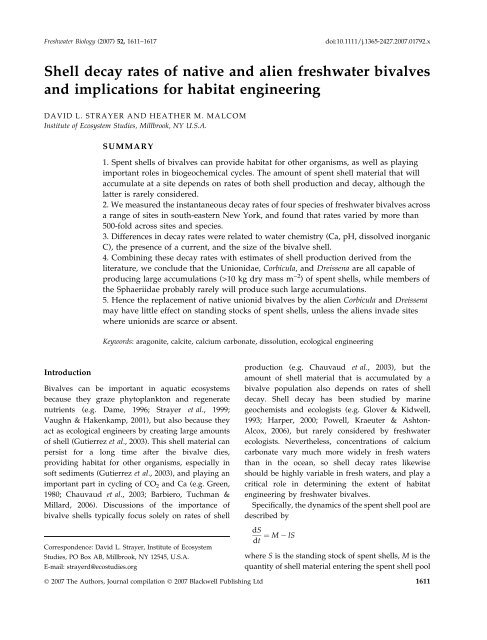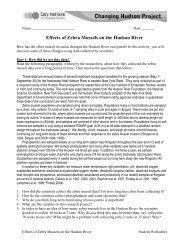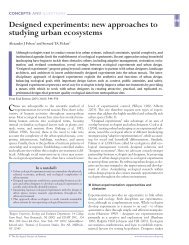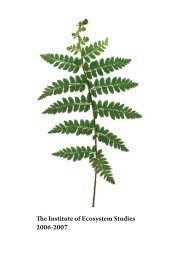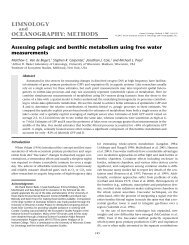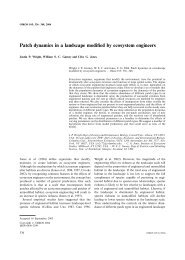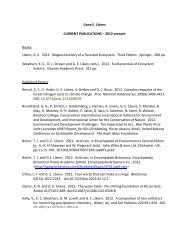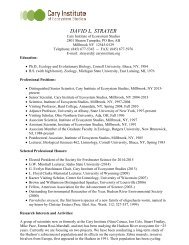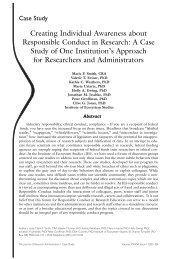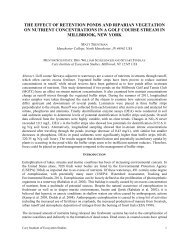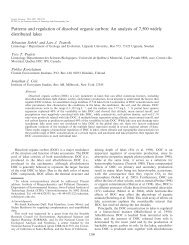Shell decay rates of native and alien freshwater bivalves and ...
Shell decay rates of native and alien freshwater bivalves and ...
Shell decay rates of native and alien freshwater bivalves and ...
You also want an ePaper? Increase the reach of your titles
YUMPU automatically turns print PDFs into web optimized ePapers that Google loves.
Freshwater Biology (2007) 52, 1611–1617doi:10.1111/j.1365-2427.2007.01792.x<strong>Shell</strong> <strong>decay</strong> <strong>rates</strong> <strong>of</strong> <strong>native</strong> <strong>and</strong> <strong>alien</strong> <strong>freshwater</strong> <strong>bivalves</strong><strong>and</strong> implications for habitat engineeringDAVID L. STRAYER AND HEATHER M. MALCOMInstitute <strong>of</strong> Ecosystem Studies, Millbrook, NY U.S.A.SUMMARY1. Spent shells <strong>of</strong> <strong>bivalves</strong> can provide habitat for other organisms, as well as playingimportant roles in biogeochemical cycles. The amount <strong>of</strong> spent shell material that willaccumulate at a site depends on <strong>rates</strong> <strong>of</strong> both shell production <strong>and</strong> <strong>decay</strong>, although thelatter is rarely considered.2. We measured the instantaneous <strong>decay</strong> <strong>rates</strong> <strong>of</strong> four species <strong>of</strong> <strong>freshwater</strong> <strong>bivalves</strong> acrossa range <strong>of</strong> sites in south-eastern New York, <strong>and</strong> found that <strong>rates</strong> varied by more than500-fold across sites <strong>and</strong> species.3. Differences in <strong>decay</strong> <strong>rates</strong> were related to water chemistry (Ca, pH, dissolved inorganicC), the presence <strong>of</strong> a current, <strong>and</strong> the size <strong>of</strong> the bivalve shell.4. Combining these <strong>decay</strong> <strong>rates</strong> with estimates <strong>of</strong> shell production derived from theliterature, we conclude that the Unionidae, Corbicula, <strong>and</strong> Dreissena are all capable <strong>of</strong>producing large accumulations (>10 kg dry mass m )2 ) <strong>of</strong> spent shells, while members <strong>of</strong>the Sphaeriidae probably rarely will produce such large accumulations.5. Hence the replacement <strong>of</strong> <strong>native</strong> unionid <strong>bivalves</strong> by the <strong>alien</strong> Corbicula <strong>and</strong> Dreissenamay have little effect on st<strong>and</strong>ing stocks <strong>of</strong> spent shells, unless the <strong>alien</strong>s invade siteswhere unionids are scarce or absent.Keywords: aragonite, calcite, calcium carbonate, dissolution, ecological engineeringIntroductionBivalves can be important in aquatic ecosystemsbecause they graze phytoplankton <strong>and</strong> regeneratenutrients (e.g. Dame, 1996; Strayer et al., 1999;Vaughn & Hakenkamp, 2001), but also because theyact as ecological engineers by creating large amounts<strong>of</strong> shell (Gutierrez et al., 2003). This shell material canpersist for a long time after the bivalve dies,providing habitat for other organisms, especially ins<strong>of</strong>t sediments (Gutierrez et al., 2003), <strong>and</strong> playing animportant part in cycling <strong>of</strong> CO 2 <strong>and</strong> Ca (e.g. Green,1980; Chauvaud et al., 2003; Barbiero, Tuchman &Millard, 2006). Discussions <strong>of</strong> the importance <strong>of</strong>bivalve shells typically focus solely on <strong>rates</strong> <strong>of</strong> shellCorrespondence: David L. Strayer, Institute <strong>of</strong> EcosystemStudies, PO Box AB, Millbrook, NY 12545, U.S.A.E-mail: strayerd@ecostudies.orgproduction (e.g. Chauvaud et al., 2003), but theamount <strong>of</strong> shell material that is accumulated by abivalve population also depends on <strong>rates</strong> <strong>of</strong> shell<strong>decay</strong>. <strong>Shell</strong> <strong>decay</strong> has been studied by marinegeochemists <strong>and</strong> ecologists (e.g. Glover & Kidwell,1993; Harper, 2000; Powell, Kraeuter & Ashton-Alcox, 2006), but rarely considered by <strong>freshwater</strong>ecologists. Nevertheless, concentrations <strong>of</strong> calciumcarbonate vary much more widely in fresh watersthan in the ocean, so shell <strong>decay</strong> <strong>rates</strong> likewiseshould be highly variable in fresh waters, <strong>and</strong> play acritical role in determining the extent <strong>of</strong> habitatengineering by <strong>freshwater</strong> <strong>bivalves</strong>.Specifically, the dynamics <strong>of</strong> the spent shell pool aredescribed bydSdt ¼ M lSwhere S is the st<strong>and</strong>ing stock <strong>of</strong> spent shells, M is thequantity <strong>of</strong> shell material entering the spent shell poolÓ 2007 The Authors, Journal compilation Ó 2007 Blackwell Publishing Ltd 1611
1612 D. L. Strayer <strong>and</strong> H. M. Malcomthrough mortality <strong>of</strong> living animals <strong>and</strong> l is theinstantaneous loss rate <strong>of</strong> spent shells. At steady state,mortality is equal to the production <strong>of</strong> spent shells (P)<strong>and</strong> dS=dt ¼ 0, so the quantity <strong>of</strong> spent shell materialwill be P=l. Rates <strong>of</strong> shell loss should depend on waterchemistry <strong>and</strong> current speed, <strong>and</strong> should also varysubstantially across bivalve species that differ in shellsize <strong>and</strong> composition.Highly variable <strong>rates</strong> <strong>of</strong> shell production <strong>and</strong> lossacross <strong>freshwater</strong> environments <strong>and</strong> bivalve specieswill lead to wide variation in the importance <strong>of</strong>habitat engineering by <strong>freshwater</strong> <strong>bivalves</strong>. In particular,the widespread replacement <strong>of</strong> <strong>native</strong><strong>bivalves</strong> with <strong>alien</strong>s such as Dreissena spp. <strong>and</strong>Corbicula spp. at many sites around the world (e.g.Karatayev, Burlakova & Padilla, 2005) raises thepossibility that important changes in habitat engineeringmay accompany these species replacements.Nevertheless, the very few measurements that havebeen made <strong>of</strong> either shell production (Aldridge &McMahon, 1978; Strayer et al., 1981; Vincent, Vaillancourt& Lafontaine, 1981; Vincent & Lafontaine,1984) or <strong>decay</strong> (Strayer et al., 1981) by <strong>freshwater</strong><strong>bivalves</strong> are insufficient to evaluate the importance<strong>of</strong> habitat engineering by <strong>freshwater</strong> <strong>bivalves</strong> acrossenvironments or species.The goals <strong>of</strong> our study were to measure <strong>rates</strong> <strong>of</strong>shell loss <strong>of</strong> the four major groups <strong>of</strong> <strong>freshwater</strong><strong>bivalves</strong> (Unionidae, Corbiculidae, Sphaeriidae, Dreissenidae)across a range <strong>of</strong> environments differingin water chemistry <strong>and</strong> current speed. We combinethis information with available data on shell productionto identify the environments <strong>and</strong> species forwhich habitat engineering is most important, <strong>and</strong>assess whether replacement <strong>of</strong> <strong>native</strong>s by <strong>alien</strong>sis likely to be important in changing habitat engineering.MethodsOur basic approach was to deploy ‘litter bags’containing shells <strong>of</strong> different species <strong>of</strong> <strong>bivalves</strong> acrossa range <strong>of</strong> sites differing in water movement <strong>and</strong>chemistry. We chose the study sites to represent awide range <strong>of</strong> chemical <strong>and</strong> physical conditions in asmall geographic area (Table 1). The four <strong>bivalves</strong>pecies chosen (Table 2) are common representatives<strong>of</strong> the four families <strong>of</strong> <strong>bivalves</strong> that are now widespreadin fresh waters across the Northern Hemisphere.The shells <strong>of</strong> all <strong>of</strong> these families arecomposed <strong>of</strong> aragonite rather than calcite; only theshells <strong>of</strong> unionids contain internal layers <strong>of</strong> conchiolin(Compere & Bates, 1973; Kat, 1985; Fritz et al., 1990;Pathy & Mackie, 1993). We used both fresh spentshells (Corbicula fluminea, Elliptio complanata, <strong>and</strong>Sphaerium striatinum) <strong>and</strong> shells from living animals(Dreissena polymorpha <strong>and</strong> Sphaerium striatinum). Spentshells were rinsed to remove dirt <strong>and</strong> debris, then airdried;living animals were killed by freezing, then thebodies were removed from the shells <strong>and</strong> the shellswere air-dried.We made litter bags out <strong>of</strong> 1.6-mm mesh fibreglasswindow screening. Each bag contained several preweighedvalves <strong>of</strong> a single bivalve species plus anumbered aluminum tag, <strong>and</strong> was sealed with asoldering iron. We cabled each bag onto a 30-cm steelspike, which we drove into the sediments in theshallow water (approximately 0.5 m deep at lowwater) at each study site (Table 1). Bags were widelydispersed (>1 m apart) over the study site <strong>and</strong> restedflat on the sediment surface. We placed bags into thefield on 7–8 October 2004 <strong>and</strong> retrieved them on 13–14September 2005. A large flood moved a few <strong>of</strong> thebags from the Neversink River <strong>and</strong> Spring Brook ontothe floodplain on 3 April 2005; we collected these bagsTable 1 Characteristics <strong>of</strong> the study sites, including means <strong>and</strong> ranges (in parentheses) <strong>of</strong> water-chemistry variables over the fourcollection times. Running-water sites had s<strong>and</strong> <strong>and</strong> gravel bottoms; st<strong>and</strong>ing-water sites had mud bottomsSite pH DIC (mg L )1 ) Ca (mg L )1 )Duck Pond, Ulster Co., New York 7.36 (7.1–7.6) 10.7 (8.3–12.3) 10.2 (7.7–11.7)East Branch Wappinger Creek, Dutchess Co., New York 7.99 (7.6–8.4) 25.9 (17.6–30.8) 29.6 (23.3–38.4)Fowler Road Pond, Dutchess Co., New York 7.23 (6.5–7.6) 5.58 (4.3–7.3) 5.66 (4.1–8.5)Neversink River, Orange Co., New York 7.28 (6.8–7.8) 3.95 (3.2–5.0) 7.13 (6.5–7.8)Spring Brook, Orange Co., New York 6.63 (6.2–6.9) 7.26 (6.2–8.6) 9.95 (9.4–10.5)Spring Lake, Dutchess Co., New York 8.03 (7.5–8.4) 28.8 (25.4–31.1) 39.6 (29.5–45.7)Ó 2007 The Authors, Journal compilation Ó 2007 Blackwell Publishing Ltd, Freshwater Biology, 52, 1611–1617
Bivalve shell <strong>decay</strong> 1613Table 2 Characteristics <strong>of</strong> the four studied bivalve species. Initial weights exclude weathered shellsNumber <strong>of</strong> bagsdeployed/recovered% organicmatterMean initial drymass (g/valve)Number <strong>of</strong>valves/bagNative or <strong>alien</strong>to North America Source <strong>of</strong> shellsSpeciesCorbicula fluminea (Müller) (Corbiculidae) Alien Green River, Kentucky 10 1.90 2.91 58/44Dreissena polymorpha (Pallas) (Dreissenidae) Alien Hudson River, New York 30 0.135 3.29 48/33Elliptio complanata (Lightfoot) (Unionidae) Native Neversink River, New York 7 6.57 5.86 58/4415 0.33 2.85 34/21Sphaerium striatinum (Lamarck) (Sphaeriidae) Native Little Wappinger Creek,New Yorkon 2 June 2005. In total, we recovered 142 <strong>of</strong> the 198bags initially deployed (Table 2).At each site, we placed eight bags <strong>of</strong> each speciesexcept for Sphaerium, for which insufficient materialforced us to deploy just four bags/site. We alsoprepared a few additional litter bags containingsomewhat weathered shells; our analyses showed nostatistical differences in <strong>decay</strong> <strong>rates</strong> between fresh <strong>and</strong>weathered shells, so we included these additionalbags in all <strong>of</strong> our analyses.After bags were retrieved from the field, shells wereremoved, lightly rinsed to remove debris, air-dried,weighed, ashed at 450 °C for 8 h <strong>and</strong> then reweighed.We assume that the ash-free dry mass representsCaCO 3 , <strong>and</strong> the mass lost on ashing representsorganic matter. At least 10 bags <strong>of</strong> shells <strong>of</strong> eachspecies identical to those deployed in the field werekept back for measurement <strong>of</strong> initial organic <strong>and</strong>CaCO 3 content.We measured water chemistry at each site fourtimes over the course <strong>of</strong> the study (October 2004, <strong>and</strong>January, June <strong>and</strong> September 2005). We measured pHin the field with an Accumet AP60 Series pH meter(Fisher Scientific, Pittsburgh, PA, U.S.A.). We tooksamples for dissolved inorganic C (DIC) in 300-mLglass BOD bottles <strong>and</strong> refrigerated the samples untilmeasuring DIC on a Shimadzu 8A gas chromatograph(Shimadzu Scientific Instruments, Columbia, MD,U.S.A.) with thermal conductivity detector (Stainton,1974). Ca was measured with a Leeman Labs InductivelyCoupled Plasma Spectrometer (Teledyne Technologies,Los Angeles, CA, U.S.A.) on samples takenin clean polyethylene bottles. The sites ranged fromhighly undersaturated with CaCO 3 to two sites(Spring Lake <strong>and</strong> the East Branch <strong>of</strong> WappingerCreek) that fluctuated between supersaturation <strong>and</strong>undersaturation on different sampling dates, accordingto the equations in Butler (1991). Water movementwas assessed as a binary variable (i.e. running waterversus st<strong>and</strong>ing water).We calculated the instantaneous rate <strong>of</strong> shell loss(k, year )1 )as k ¼ð1=tÞ lnmass finalmass initialwhere t is the length <strong>of</strong> time (in years) that the shellswere in the water. We calculated k separately for thebulk shell material, the organic fraction <strong>of</strong> the shell<strong>and</strong> the CaCO 3 fraction <strong>of</strong> the shell.Ó 2007 The Authors, Journal compilation Ó 2007 Blackwell Publishing Ltd, Freshwater Biology, 52, 1611–1617
1614 D. L. Strayer <strong>and</strong> H. M. MalcomThree <strong>of</strong> the litter bags contained no shell materialwhen they were recovered, making it impossible forus to estimate k. Simply discarding data from thesebags would have biased our estimates <strong>of</strong> <strong>decay</strong> <strong>rates</strong>,so we estimated k by assuming that the amount <strong>of</strong>shell material remaining in these bags was half <strong>of</strong> theminimum remaining mass we observed for thatspecies at that site. We discarded data from onebag <strong>of</strong> Elliptio from the East Branch <strong>of</strong> WappingerCreek as an outlier because k for this bag was )0.50,whereas other bags from this site had k ¼ )0.03 to)0.06.-k (year –1 )<strong>Shell</strong> dry mass (g)Fig. 2 Decay <strong>rates</strong> <strong>of</strong> four different species <strong>of</strong> <strong>freshwater</strong> <strong>bivalves</strong>,averaged over all study sites except the Neversink River(at which no Sphaerium bags survived), as a function <strong>of</strong> meanshell mass <strong>of</strong> each species (r 2 ¼ 0.86, P < 0.04). Full speciesnames are given in Table 2.ResultsInstantaneous <strong>decay</strong> <strong>rates</strong> <strong>of</strong> bulk shell materialvaried enormously, ranging from )0.01 to 99%.Decay <strong>rates</strong> were significantly related to both <strong>bivalves</strong>pecies (two-way ANOVA, F ¼ 17.2, P < 0.0001) <strong>and</strong>site (F ¼ 12.9, P < 0.0001). Differences in <strong>decay</strong> <strong>rates</strong>among sites were correlated with both water movement<strong>and</strong> chemistry, <strong>and</strong> were much faster at siteswhere the water was both moving <strong>and</strong> s<strong>of</strong>t than atsites where the water was still or hard (whetherexpressed as Ca, DIC, or pH) (Fig. 1). Differences in<strong>decay</strong> <strong>rates</strong> across species were related to the size <strong>of</strong>the shell; small shells <strong>decay</strong>ed much more quicklythan large shells (Fig. 2). Loss <strong>rates</strong> <strong>of</strong> the inorganic<strong>and</strong> organic fractions <strong>of</strong> the shell were similar (Fig. 3),although as expected <strong>decay</strong> <strong>rates</strong> <strong>of</strong> organic matterrelative to those <strong>of</strong> CaCO 3 were a little higher in hardwaters than in s<strong>of</strong>t waters.DiscussionThe very wide range in shell <strong>decay</strong> <strong>rates</strong> that weobserved can be explained by water chemistry, watermovement <strong>and</strong> the size <strong>of</strong> the bivalve shell. If the fullrange <strong>of</strong> bivalve species [adult shell mass rangingfrom 1 kg DM (dry mass)/individual] <strong>and</strong>environmental conditions in fresh waters is considered(very s<strong>of</strong>t to supersaturated with CaCO 3 ), then<strong>rates</strong> <strong>of</strong> shell <strong>decay</strong> will vary even more than the 500-fold observed in our study. Ultimately it may be(a)(c)k (year –1 )(b)(d)Dissolved calcium (mg L –1 )Fig. 1 Mean <strong>decay</strong> <strong>rates</strong> (±1 SE) <strong>of</strong> fourspecies <strong>of</strong> <strong>freshwater</strong> <strong>bivalves</strong> across arange <strong>of</strong> sites in south-eastern New York,as a function <strong>of</strong> dissolved Ca in the water.Species are (a) Corbicula fluminea, (b) Dreissenapolymorpha, (c) Elliptio complanata<strong>and</strong> (d) Sphaerium striatinum. Note thelarge differences in scales on the Y-axes.Ó 2007 The Authors, Journal compilation Ó 2007 Blackwell Publishing Ltd, Freshwater Biology, 52, 1611–1617
1616 D. L. Strayer <strong>and</strong> H. M. Malcom(a)(c)k (year –1 )(b)(d)<strong>Shell</strong> production (g DM m –2 year –1 )Fig. 4 Estimated steady-state st<strong>and</strong>ingstocks <strong>of</strong> spent shells (contour lines, ingDMm )2 year )1 ) for four species <strong>of</strong> <strong>bivalves</strong>as a function <strong>of</strong> <strong>rates</strong> <strong>of</strong> shell production<strong>and</strong> <strong>decay</strong>: (a) Corbicula fluminea;(b) Dreissena polymorpha; (c) Elliptio complanata;(d) Sphaerium striatinum. Heavyrectangles delimit the range <strong>of</strong> production<strong>and</strong> <strong>decay</strong> <strong>rates</strong> most likely to occur innature for each bivalve (see text forexplanation).dense populations <strong>of</strong> <strong>bivalves</strong> will be important inhabitat creation or sequestration <strong>of</strong> calcium carbonate.In contrast, in hard water or in lakes, even modestpopulations <strong>of</strong> <strong>bivalves</strong> may accumulate largeamounts <strong>of</strong> spent shells, <strong>and</strong> the combination <strong>of</strong> hardwater, high shell production, <strong>and</strong> large shells (such asmay have prevailed in Midwestern rivers in pre-Columbian times) may lead to very substantial (10–100 kg m )2 ) shell accumulation, with important consequencesfor habitat structure <strong>and</strong> biogeochemicalcycling.Surprisingly, Fig. 4 suggests that the replacement <strong>of</strong><strong>native</strong> unionids by Corbicula or Dreissena will notalways have large effects on the st<strong>and</strong>ing stocks <strong>of</strong>spent shells in <strong>freshwater</strong> ecosystems. If dense populations<strong>of</strong> unionids are simply displaced by Corbiculaor Dreissena, the high shell production <strong>rates</strong> <strong>of</strong> the<strong>alien</strong> <strong>bivalves</strong> may compensate for their relativelyhigh <strong>decay</strong> <strong>rates</strong> <strong>and</strong> have little net effect on thest<strong>and</strong>ing stock <strong>of</strong> spent shell material. However, if the<strong>alien</strong>s move into sites where <strong>native</strong> <strong>bivalves</strong> are scarceor absent, habitat engineering by the <strong>alien</strong>s mayfundamentally alter habitat structure <strong>and</strong> materialcycling by increasing st<strong>and</strong>ing stocks <strong>of</strong> spent shells.Of course, even if st<strong>and</strong>ing stocks <strong>of</strong> spent shells areunchanged, the quality (size, surface area for biogeochemicalreactions, mobility, resistance to crushing)<strong>of</strong> spent shells <strong>and</strong> shell fragments <strong>of</strong> the <strong>alien</strong>may differ markedly from that <strong>of</strong> the <strong>native</strong> unionids,especially in the case <strong>of</strong> Dreissena. Little is knownabout the ecological significance <strong>of</strong> such qualitativechanges, which may be important in determining thenature <strong>of</strong> <strong>freshwater</strong> benthic habitats.AcknowledgmentsWe thank Jim Layzer for providing Corbicula shells,Jon Cole for helpful discussions, Caryn Vaughn,Roger Jones <strong>and</strong> anonymous reviewers for helpfulcomments, the IES analytical lab for Ca analyses, theMohonk Preserve <strong>and</strong> The Nature Conservancy forproviding access to study sites, <strong>and</strong> the A.W. MellonFoundation for funding. This is a contribution to theprogram <strong>of</strong> the Institute <strong>of</strong> Ecosystem Studies.ReferencesAldridge D.W. & McMahon R.F. (1978) Growth, fecundity,<strong>and</strong> bioenergetics in a natural population <strong>of</strong> theAsiatic <strong>freshwater</strong> clam, Corbicula manilensis Philippi,Ó 2007 The Authors, Journal compilation Ó 2007 Blackwell Publishing Ltd, Freshwater Biology, 52, 1611–1617
Bivalve shell <strong>decay</strong> 1617from north central Texas. Journal <strong>of</strong> Molluscan Studies,44, 49–70.Barbiero R.P., Tuchman M.L. & Millard E.S. (2006) Postdreissenidincreases in transparency during summerstratification in the <strong>of</strong>fshore waters <strong>of</strong> Lake Ontario: isa reduction in whiting events the cause? Journal <strong>of</strong>Great Lakes Research, 32, 131–141.Butler J.N. (1991) Carbon Dioxide Equilibria <strong>and</strong> theirApplications. CRC Press, Chelsea, MI, U.S.A.Chase M.E. & Bailey R.C. (1996) Recruitment <strong>of</strong> Dreissenapolymorpha: does the presence <strong>and</strong> density <strong>of</strong> conspecificsdetermine the recruitment density <strong>and</strong> pattern ina population? Malacologia, 38, 19–31.Chase M.E. & Bailey R.C. (1999) The ecology <strong>of</strong> the zebramussel (Dreissena polymorpha) in the lower Great Lakes<strong>of</strong> North America: II. Total production, energy allocation,<strong>and</strong> reproductive effort. Journal <strong>of</strong> Great LakesResearch, 25, 122–134.Chauvaud L., Thompson J.K., Cloern J.E. & Thouzeau G.(2003) Clams as CO 2 generators: the Potamocorbulaexample in San Francisco Bay. Limnology <strong>and</strong> Oceanography,48, 2086–2092.Cleven E.-J. & Frenzel P. (1993) Population dynamics <strong>and</strong>production <strong>of</strong> Dreissena polymorpha (Pallas) in RiverSeerhein, the outlet <strong>of</strong> Lake Constance (Obersee).Archiv fu}r Hydrobiologie, 127, 395–407.Compere E.L. & Bates J.M. (1973) Determination <strong>of</strong>calcite: aragonite ratios in mollusc shells by infraredspectra. Limnology <strong>and</strong> Oceanography, 18, 326–331.Dame R.F. (1996) Ecology <strong>of</strong> Marine Bivalves: An EcosystemApproach. CRC Press, Boca Raton.Fritz L.W., Ragone L.M., Lutz R.A. & Swapp S. (1990)Biomineralization <strong>of</strong> barite in the shell <strong>of</strong> the <strong>freshwater</strong>Asiatic Clam Corbicula fluminea (Mollusca:Bivalvia). Limnology <strong>and</strong> Oceanography, 35, 756–762.Glover C.P. & Kidwell S.M. (1993) Influence <strong>of</strong> organicmatrix on the post-mortem destruction <strong>of</strong> molluscanshells. Journal <strong>of</strong> Geology, 101, 729–747.Green R.H. (1980) Role <strong>of</strong> a unionid clam populationin the calcium budget <strong>of</strong> a small Arctic lake.Canadian Journal <strong>of</strong> Fisheries <strong>and</strong> Aquatic Sciences, 37,219–224.Gutierrez J.L., Jones C.G., Strayer D.L. & Iribarne O.O.(2003) Mollusks as ecosystem engineers: their functionalroles as shell producers in aquatic habitats.Oikos, 101, 79–90.Harper E.M. (2000) Are calcitic layers an effectiveadaptation against shell dissolution in the Bivalvia?Journal <strong>of</strong> Zoology, 251, 179–186.Karatayev A.Y., Burlakova L.E. & Padilla D.K. (2005)Contrasting distribution <strong>and</strong> impacts <strong>of</strong> two <strong>freshwater</strong>exotic suspension feeders, Dreissena polymorpha<strong>and</strong> Corbicula fluminea. In: The Comparative Roles <strong>of</strong>Suspension-feeders in Ecosystems (Eds R.F. Dame &S. Olenin), pp. 239–262. Springer, Dordrecht.Kat P.W. (1985) Convergence in bivalve conchiolin layermicrostructure. Malacological Review, 18, 97–106.Nalepa T.F. & Gauvin J.M. (1988) Distribution, abundance,<strong>and</strong> biomass <strong>of</strong> <strong>freshwater</strong> mussels (Bivalvia:Unionidae) in Lake St. Clair. Journal <strong>of</strong> Great LakesResearch, 14, 411–419.Pathy D.A. & Mackie G.L. (1993) Comparative shellmorphology <strong>of</strong> Dreissena polymorpha, Mytilopsis leucophaeta,<strong>and</strong> the ‘‘quagga’’ mussel in North America.Canadian Journal <strong>of</strong> Zoology, 71, 1012–1023.Powell E.N., Kraeuter J.N. & Ashton-Alcox K.A. (2006)How long does an oyster reef last? Estuarine, Coastal<strong>and</strong> Shelf Science, 69, 531–542.Stainton M.P. (1974) A syringe gas-stripping procedurefor gas-chromatographic determination <strong>of</strong> dissolvedinorganic <strong>and</strong> organic carbon in <strong>freshwater</strong> <strong>and</strong>carbonates in sediments. Journal <strong>of</strong> the Fisheries ResearchBoard <strong>of</strong> Canada, 30, 1441–1445.Strayer D.L., Cole J.J., Likens G.E. & Buso D.C. (1981)Biomass <strong>and</strong> annual production <strong>of</strong> the <strong>freshwater</strong>mussel Elliptio complanata in an oligotrophic s<strong>of</strong>twaterlake. Freshwater Biology, 11, 435–440.Strayer D.L., Hunter D.C., Smith L.C. & Borg C. (1994)Distribution, abundance, <strong>and</strong> role <strong>of</strong> <strong>freshwater</strong> clams(Bivalvia: Unionidae) in the <strong>freshwater</strong> tidal HudsonRiver. Freshwater Biology, 31, 239–248.Strayer D.L., Caraco N.F., Cole J.J., Findlay S. & Pace M.L.(1999) Transformation <strong>of</strong> <strong>freshwater</strong> ecosystems by<strong>bivalves</strong>: a case study <strong>of</strong> zebra mussels in the HudsonRiver. BioScience, 49, 19–27.Vaughn C.C. & Hakenkamp C.C. (2001) The functionalrole <strong>of</strong> burrowing <strong>bivalves</strong> in <strong>freshwater</strong> ecosystems.Freshwater Biology, 46, 1431–1446.Vincent B. & Lafontaine N. (1984) Cycle de développement,croissance et production de Sphaerium striatinum(Bivalvia: Pisidiidae) dans le Saint-Laurent (Québec).Canadian Journal <strong>of</strong> Zoology, 62, 2418–2424.Vincent B., Vaillancourt G. & Lafontaine N. (1981) Cyclede développement, croissance et production de Pisidiumamnicum (Mollusca: Bivalvia) dans le Saint-Laurent (Québec). Canadian Journal <strong>of</strong> Zoology, 62,2418–2424.Walz N. (1979) The energy balance <strong>of</strong> the <strong>freshwater</strong>mussel Dreissena polymorpha Pallas in laboratoryexperiments <strong>and</strong> in Lake Constance. V. Seasonal <strong>and</strong>nutritional changes in the biochemical composition.Archiv fu}r Hydrobiologie Supplementb<strong>and</strong>, 55, 235–254.(Manuscript accepted 5 April 2007)Ó 2007 The Authors, Journal compilation Ó 2007 Blackwell Publishing Ltd, Freshwater Biology, 52, 1611–1617


